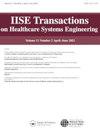医院手术室中传感器的最佳放置
IF 1.5
Q3 HEALTH CARE SCIENCES & SERVICES
IISE Transactions on Healthcare Systems Engineering
Pub Date : 2020-07-02
DOI:10.1080/24725579.2020.1790698
引用次数: 5
摘要
摘要:建筑通风系统负责提供良好的热条件,并保持可接受的室内空气质量。因此,医院的通风率非常高,以避免接触可能致命的丝线。当然,这意味着更高的能源消耗率,使医院成为最高的能源密集型建筑之一。规避这种权衡的一种方法是设计一个智能通风系统,其中空气质量由一系列传感器连续测量,其实时读数有助于调整通风率。在本文中,我们引入优化问题来研究医院手术室中传感器的最优数量和位置。特别是,我们制定了几个优化问题,以找到最优的位置和传感器,以最小化预期的检测时间。我们提出了三种求解程序来解决上述优化问题。第一种方法将蒙特卡罗模拟模型扩展并应用于我们的问题,并作为基准;第二种方法发展了一种新的分解方法以及边际效益论证来提供解决方案;第三种方法对空间上的离散概率污染分布提出了一种整数规划方法。我们将我们的方法应用于医院手术室的真实数据集,结果表明我们提出的算法是接近最优的,最佳放置对污染位置的概率密度敏感,传感器的最佳放置在病床和手术室门附近。本文章由计算机程序翻译,如有差异,请以英文原文为准。
Optimal sensor placement in a hospital operating room
Abstract Building ventilation systems are responsible for providing a favorable thermal condition, as well as maintaining acceptable indoor air quality. Thus, ventilation rates are extremely high in hospitals to avoid exposure to potentially fatal threads. This, of course, means higher energy consumption rates, making hospitals among the top energy intensive buildings. One approach to circumvent such a tradeoff is to design a smart ventilation system, where air quality is continuously measured by a series of sensors, whose real time readings help adjust the ventilation rates. In this paper, we introduce optimization problems to study the optimal number and location of sensors in a hospital operating room (OR). In particular, we formulate several optimization problems to find the optimal location and sensors to minimize the expected detection time. We propose three solution procedures to solve the said optimization problems. The first method extends and applies Monte Carlo simulation models to our problem and serves as a benchmark; the second method develops a novel decomposition approach along with a marginal benefit argument to provide solutions; and the third method develops an integer programing method for a discrete probability distribution of contamination on space. We apply our methods to a real data set from an OR of a hospital and our results show that our proposed algorithms are near-optimal, the optimal placement is sensitive to the probability density of contamination location, and optimal placement for sensors is near patient bed and OR doors.
求助全文
通过发布文献求助,成功后即可免费获取论文全文。
去求助
来源期刊

IISE Transactions on Healthcare Systems Engineering
Social Sciences-Safety Research
CiteScore
3.10
自引率
0.00%
发文量
19
期刊介绍:
IISE Transactions on Healthcare Systems Engineering aims to foster the healthcare systems community by publishing high quality papers that have a strong methodological focus and direct applicability to healthcare systems. Published quarterly, the journal supports research that explores: · Healthcare Operations Management · Medical Decision Making · Socio-Technical Systems Analysis related to healthcare · Quality Engineering · Healthcare Informatics · Healthcare Policy We are looking forward to accepting submissions that document the development and use of industrial and systems engineering tools and techniques including: · Healthcare operations research · Healthcare statistics · Healthcare information systems · Healthcare work measurement · Human factors/ergonomics applied to healthcare systems Research that explores the integration of these tools and techniques with those from other engineering and medical disciplines are also featured. We encourage the submission of clinical notes, or practice notes, to show the impact of contributions that will be published. We also encourage authors to collect an impact statement from their clinical partners to show the impact of research in the clinical practices.
 求助内容:
求助内容: 应助结果提醒方式:
应助结果提醒方式:


